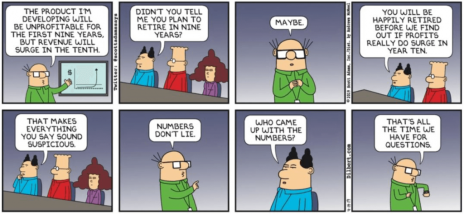The IPO market is red hot again as Lyft (LYFT), Uber (UBER), Pinterest (PINS), Zoom Video (ZM) and Beyond Meats (BYND) have gone public, or will do so soon. And while BYND soared 163% in its first day of trading last week, which was the best first day of trading for an IPO since the 2008-09 Financial Crisis, buying stocks in these companies is NOT a sure thing. But what about trading options with IPOs? I’ll get to that.
First, I think this comic best illustrates the risks in buying IPOs:
Also, as my colleague Chris Preston recently wrote, “Lyft (LYFT) is down 26% in the month since its March 29 IPO … Twitter (TWTR) was down 26% in its first six months of trading after coming public in late 2013 .. Facebook (FB) famously struggled in its first year of public trading, falling as much as 50% from its IPO price.”
So, clearly there are risks in buying IPOs shortly after they debut. However, if you use Options there are low-risk/high-reward ways to get long these stocks at a fraction of the cost of buying the stocks outright.

Read Your Free Report Here.

Read Your Free Report Here.

Read Your Free Report Here.

Read Your Free Report Here.
But first we need to understand how soon after a stock IPOs before options can be traded.
Trading Options with IPOs: How it Works
Generally, there would be a minimum of five trading days from the IPO date before listing options on any stock. And here are the remaining criteria from the Options Industry Council:
- A national stock exchange in accordance with the National Market System (NMS) lists the underlying equity.
- The underlying has a minimum price of $3 per share for five consecutive trading days prior to listing.
- There are at least 7 million publicly held shares outstanding, excluding shares held by directors or holders of 10% or more of the underlying equity shares (e.g., the public float must be 7 million or more).
- There are at least 2,000 shareholders.
Once a stock like LYFT or ZM has options tradeable there are several ways you can get bullish exposure at a fraction of the cost of buying the stock.
For example, LYFT is trading at 61 ahead of earnings today. If I was bullish on LYFT’s earnings report I might look to buy a call. A call purchase is used when a rise in the price of the underlying asset is expected. The maximum loss on this trade is the amount of premium paid.
For example, the purchase of the LYFT July 65 strike call for $4 would only risk the $4 paid, or $400 per call purchased. (Please note, a purchase of 1 of the 65 strike call is the right to buy 100 shares of stock at the strike price or 65 in this example. But because the 1 call equals 100 shares, the $4 risked is actually $400 – it’s a multiplier of 100.
If the stock were to close at 65 or below at expiration, that call purchase would be worthless, and you would lose $400. And if LYFT falls on earnings later today that call will lose a great deal of value and may even be worthless.
However, if the stock were to go above 65, the holder of this call would make $100 per contract purchased per point above 69. (Breakeven on this trade is calculated by adding the price paid for the call ($4) to the strike price (65) … 65 + 4 = 69.)
Another way to get bullish exposure is to Sell Puts.
A Put-Write strategy, also called “selling naked puts,” is used when a rise in the price of the underlying asset is expected, or a significant decline is not expected.
This strategy is often used by traders who are willing to enter a long stock position in a stock at a lower price than the stock is currently trading at.
This strategy is the sale of a put at a specific strike price with the potential for loss until the stock hits zero. The maximum profit on this trade is the amount of premium received. Think writing insurance against a big fall in the stock. Every month you collect a small premium.
And here is an example of a large put sale made by a big trader recently in ZM:
Seller of 2,000 Zoom Video (ZM) June 70 Puts for $6.70 – Stock at 72.8
Here is the breakdown on the profit and loss of this trade:
- If the stock closes above 70 this trader will make $1.34 million as the puts that he sold will expire worthless (2,000 x 670 = 1.34 million).
- If the stock closes below 70 on June expiration this trader will be long 200,000 shares. However, his breakeven is at 63.30 (70 strike price minus the 6.70 collected = 63.30).
- Below 63.30 this trader will lose $200,000 per dollar the stock falls.
And while the third scenario seems terrible, in reality this trader likely said to himself, “The stock is trading at 72.8, and I’m willing to buy 200,000 shares at 70, with a breakeven on the trade at 63.30.”
Trading options with IPOs can be extremely dicey, but as the LYFT and ZM examples above show there are ways to get bullish exposure at a fraction of the cost, and the chance to purchase these young stocks outright at lower levels.
To receive additional advice on how to trade options and how to make profitable options trades consider joining Cabot Options Trader. For details, click here.
I’d also like to invite you to my upcoming FREE webinar, “6 Tips for Making Money Trading Options + 2 Hot Trades Now.” It will take place on May 23 at 2 p.m. ET, and it will include some of the best tips I’ve learned in my nearly two decades of trading options, plus two potentially very high-reward options trades I like right now. Click here to register. Again - it’s free!

Learn More

Learn More

Learn More

Learn More


